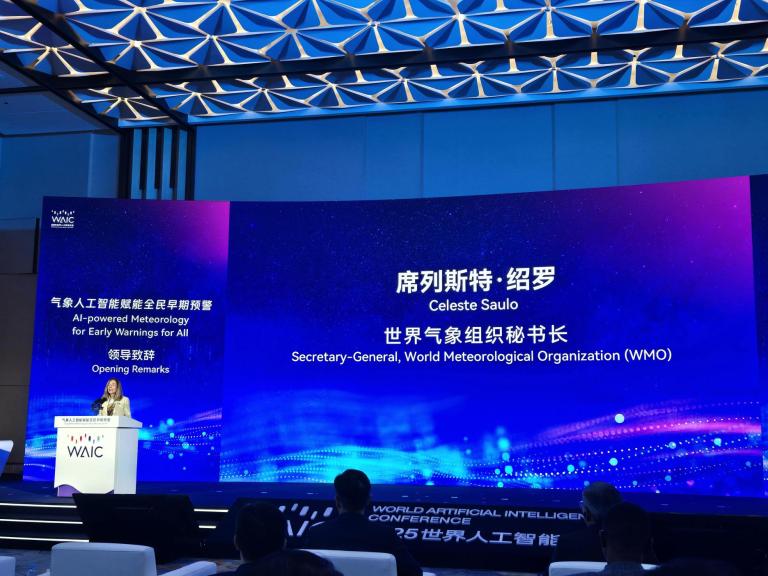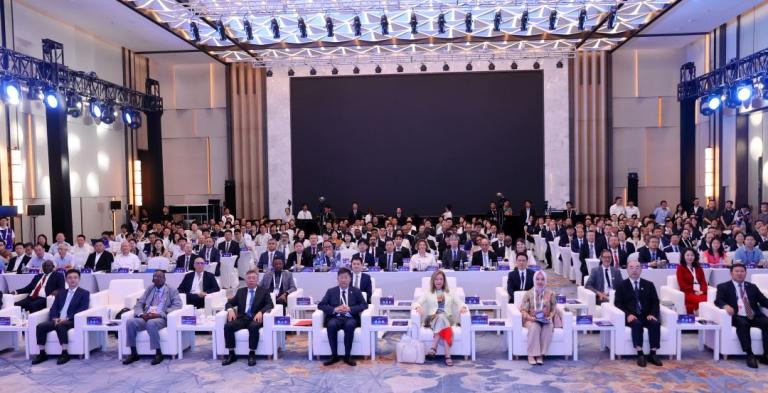The China Meteorological Administration (CMA) and World Meteorological Organization (WMO) have co-sponsored a meteorological forum during the 2025 World Artificial Intelligence Conference (WAIC) in Shanghai, China, to explore the potential of AI to improve forecasts and warnings and protect lives and economies.
The meteorological forum, AI-powered Meteorology for Early Warnings For All was held from 26-27 July and hosted by the Shanghai Municipal Government. It brought together experts from 26 countries and international organizations, as well as 180 Chinese representatives from government, academia and the private sector. It saw the launch of major new Chinese AI initiatives for multi-hazard early warnings and for space weather.
"My message today is simple. We must harness the power of prediction. We must mainstream AI-powered weather and climate intelligence into every early warning and decision-making system-because lives depend on it," WMO Secretary-General Celeste Saulo told the high-level opening event.
"Let us ensure AI becomes not a barrier but a bridge-not a luxury for some, but a lifeline for all. Let us be remembered not for having the tools and failing to use them, but for acting-together, and in time," she said.

MAZU initiative
CMA launched MAZU, a Joint Action for Early Warnings for All, to build an Early Warning Service Network and to share practical experience and technological achievements with global partners.
MAZU's mission includes the provision of early warning technical support, enhancement of capacity building, strengthening risk identification and assessment systems, and development of cooperation mechanisms and models.
Through the MAZU partnership, CMA is committed to bridging critical gaps in early warning capabilities and addressing escalating climate challenges together.
"Ensuring universal access to meteorological early warning systems is not only a shared vision of the global community, but also an important mission of China's meteorological departments." said Dr. CHEN Zhenlin, Administrator of CMA.
In recent years, CMA has jointly developed cloud-based early warning systems with the meteorological departments of Pakistan, Ethiopia, the Solomon Islands and other countries, in a showcase for South-South cooperation.
"The Ethiopian Meteorological Institute (EMI) and CMA have carried out fruitful cooperation. Through the joint development of early warning systems, we have enhanced the capabilities in disaster prevention and mitigation, as well as serving economic and social development." said Mr. Fetene Teshome, Director of EMI.
Heads of the National Meteorological and Hydrological Services (NMHSs) from other developing countries also presented their perspective.
During the keynote speech session, experts from WMO, Indonesia's Agency for Meteorology, Climatology and Geophysics (BMKG), National Meteorological Centre (NMC) of CMA, European Centre for Medium-Range Weather Forecasts (ECMWF) and New Development Bank (NDB) delivered reports.
WMO's partners in the Early Warnings For All Initiative - the United Nations (UN) Office for Disaster Risk Reduction (UNDRR), International Telecommunication Union (ITU), and International Federation of Red Cross and Red Crescent Societies (IFRC) - also participated.
At the Meteorological Forum, CMA also unveiled "Fengyu", the world's first full-chain AI forecasting model for space weather .
To tackle the impacts of solar storms on global satellite communications, navigation, and critical infrastructure, "Fengyu" caters to the demands of future deep space exploration and orbital safety. It breaks through the technological bottlenecks of traditional numerical models in terms of timeliness and efficiency.

WMO Action
WMO's Executive Council in June 2025 agreed on a bold AI Action Plan . This plan seeks to leverage the potential of AI to revolutionize forecasting while upholding the highest scientific and ethical standards and the role of NMHSs as the single authoritative voice on weather, climate, and water-related warnings and services.
Over 90% of all disasters are weather, climate, and water-related. And yet, as extremes escalate with climate change, many regions still lack access to the basic tools of anticipation.
WMO is seeking to harness innovation to close these gaps, and is exploring the deployment of AI weather predictions in data sparse areas.
A new Joint Advisory Group on AI will guide WMO activities on the development and use of AI technologies and will seek to accelerate integration of AI into the WMO infrastructure and research activities.
The EC-79 resolution has a targeted plan to develop technical guidelines on the use of AI-based Earth System prediction technologies in the WMO Integrated Processing and Prediction System (WIPPS). WMO takes an approach to address key issues and challenges through the WIPPS pilot projects and other projects:
- A WIPPS pilot study on global riverine flood prediction products will explore whether global prediction products including those from non-traditional sources can complement existing forecasting capabilities, especially in areas where capacity is limited.
- WMO supported AI pilot projects for flood forecasting in Nigeria, Viet Nam, Uruguay, and Czechia helped detect early signals that could have otherwise been missed.
- WMO is helping Regional Climate Centres in Africa, the Caribbean, and the Pacific apply AI to sub-seasonal forecasting.
- WMO is testing AI powered nowcasting applications alongside with the private sector on three regions such as Africa, Asia and Latin America.
- WMO is working with national partners to improve renewable energy forecasting in Latin America.
- WMO supports the AIM for Scale programme, delivering tailored AI-powered services to smallholder farmers in 30 countries by 2027.
On the other hand, AI tools and innovative technologies have been developed by non-traditional sources, including those in private sector entities and academia. The EC endorsed policy guidance on the contribution of these non-traditional sources, including those using artificial intelligence, to WIPPS, aiming to facilitate their contribution to support public weather, climate, hydrological, marine, and relevant services provided by NMHSs.
"But we are realistic: AI still faces limitations, especially for local high-impact events. These must be addressed before deployment," said Celeste Saulo.
"To that end, we have launched several pilot initiatives-from AI for Nowcasting to tropical cyclone analysis in partnership with our long-standing collaborator the Economic and Social Commission for Asia-Pacific, as well as an intercomparison of AI-powered prediction systems under the WMO Working Group on Numerical Experiments and the AI Weather Quest with the European Centre for Medium Range Weather Forecasting," she said.
WMO is also working closely with ITU and many other partners within the Global Initiative on Resilience to Natural Hazards through AI Solutions and the AI for EW4All sub-group to harness AI along the whole hydrometeorological value chain and across all EW4All Pillars.
Looking ahead, WMO will convene its AI Strategic Conference this September in Abu Dhabi, hosted by the National Centre for Meteorology of the United Arab Emirates to explore how public-private-academic collaboration can accelerate the delivery of the transformative potential of AI in advancing weather, climate, water, and environmental prediction services for all across the world.
In October, the Extraordinary World Meteorological Congress will chart the course toward AI-integrated global forecasting systems.






